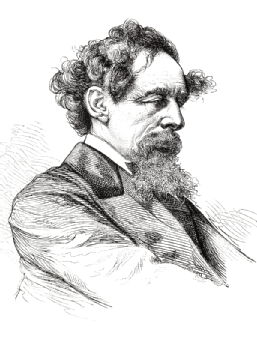Biography of Charles Dickens
 Charles John Huffman Dickens was born in Portsmouth on February 7, 1812, to John and Elizabeth Dickens. At the age of three the family left the south coast and went to live in London where a young Charles attended school, only for his education to abruptly stop three years later when his father was incarcerated at Marshalsea’s Debtors Prison.
Charles John Huffman Dickens was born in Portsmouth on February 7, 1812, to John and Elizabeth Dickens. At the age of three the family left the south coast and went to live in London where a young Charles attended school, only for his education to abruptly stop three years later when his father was incarcerated at Marshalsea’s Debtors Prison.
With his father behind bars Charles was sent to work at Warren’s blacking factory, earning just six shillings a week. The appalling conditions of the factory, long thankless work and being separated from his family made a huge impression on the teenage Charles Dickens, later influencing his novels and essays – Little Dorrit was set around Marshalsea Prison and his experiences in the workhouses had a major bearing on David Copperfield, Great Expectations, and most notably Oliver Twist.
Once his father was released from prison Charles went back to school before starting his working life as a clerk at a law office in the Holborn area of London. During his time in the junior role Charles learnt how to write in shorthand and after 18 months left the profession to become a freelance crime reporter. In 1833 Charles published his first story, 'A Dinner at Poplar Walk', and turned his hand to political journalism, covering elections for the Morning Chronicle – leading in 1836 to the publication of his first collection of written work, Sketches by Boz, followed shortly after by his first novel The Posthumous Papers of the Pickwick Club.
A month after the success of The Pickwick Papers Charles Dickens married Catherine Hogarth, and had ten children with her. During March 1837 the young family moved into 48 Doughty Street, in Camden, along with Charles’ brother Frederick and Catherine’s sister Mary. Charles became very attached to Mary and later that year had to watch her die in his arms, inspiring the death of Little Nell in The Old Curiosity Shop. While at 48 Doughty Street Charles published the novels Oliver Twist, Nicholas Nickleby and Barnaby Rudge.
In 1842 Charles Dickens made his first trip to North America, giving lectures and gaining support for copyright laws and after returning to the UK published A Christmas Carol in 1843 before briefly going to live in Italy and Switzerland.
During 1846 Charles Dickens was approached by Angela Burdett Coutts, heir to the banking fortune, about setting up a home for ‘fallen’ women. At first Dickens was not keen on the idea but eventually came round and opened Urania Cottage, in Shepherds Bush. He set the rules for Urania Cottage and interviewed prospective residents, a task which undoubtedly supplied him with more ideas for characters in his books.
Once the women graduated from Urania Cottage they were required to emigrate from the UK. It is believed around 100 women passed through Urania Cottage between 1847 and 1859. During this time Dickens completed Dombey and Son, David Copperfield, Bleak House, Hard Times and Little Dorrit – all of which proved hugely popular. With the profits from these publications Dickens bought a house in Gad’s Hill, Kent.
As an up and coming author, Dickens looked up to William Shakespeare and it is rumoured he went to Stratford-upon-Avon and inscribed his initials into the window ledge of the Bard’s house. Indeed, it is believed the reason Charles wanted to move to Gad’s Hill was because Shakespeare had set some of Henry IV, Part 1 there. While at Gad’s Hill Charles co-wrote a play called The Frozen Deep and interviewed actresses for one of the main parts himself, building a relationship with one such actress – Ellen Ternan. A year after meeting Ellen, Charles separated from wife Catherine.
He continued his charity work, this time helping Great Ormond Street Hospital which was in financial trouble – speaking at fundraising events and giving public readings of his work. He enjoyed public reading and undertook his first series of public readings for personal profit in London. After a short rest period he embarked on a gruelling three month UK tour. A Tale of Two Cities and Great Expectations followed before he survived a train crash in 1865 and finished Our Mutual Friend. Dickens continued to perform public readings and in 1867 set sail for America once more, where he gave a host of readings and lectures.
Back in England, Charles again went on a public reading tour which was halted when he suffered a suspected stroke in 1869. He stopped performing and started to write The Mystery of Edwin Drood, but once he had regained his health, the following year, he insisted on a farewell reading tour.
On June 8, 1870, Charles suffered a second stroke at his home in Gad’s Hill, he failed to regain consciousness and was pronounced dead the next day, aged 58. Charles Dickens’ body was laid to rest at Poet’s Corner in Westminster Abbey.
